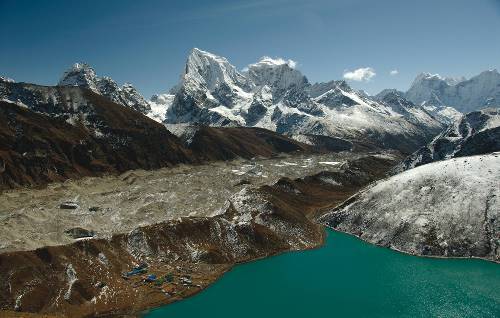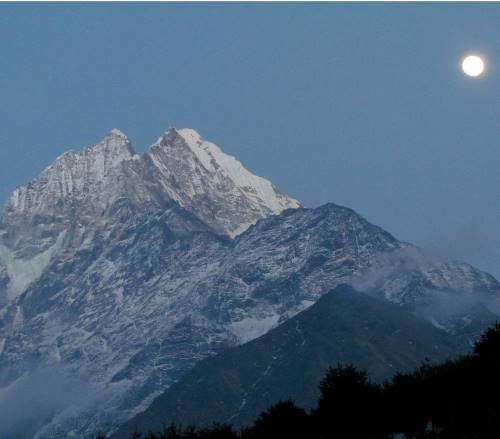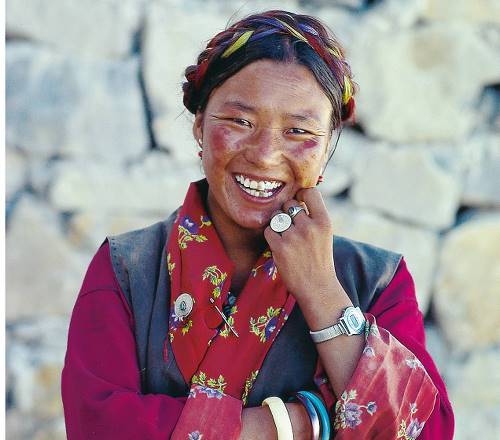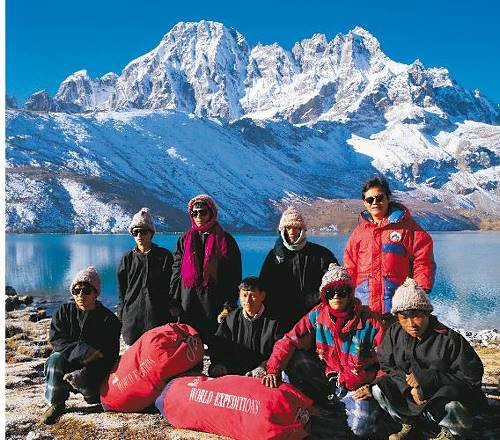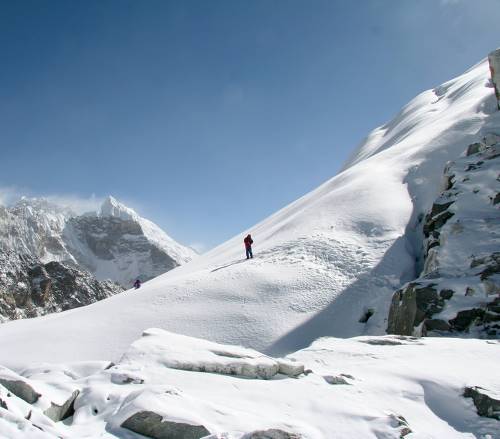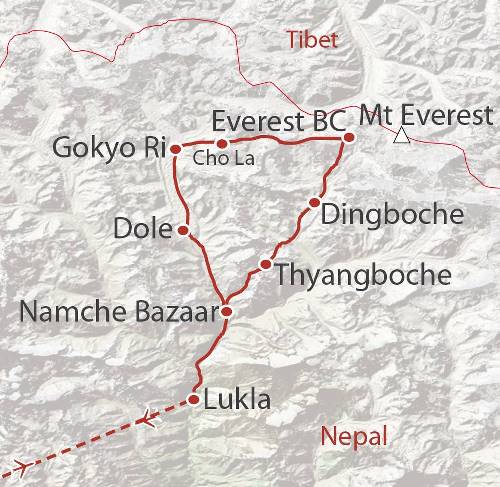Everest Circuit & the Cho La in Comfort
Everest Circuit & the Cho La in Comfort
$3390
Everest Circuit & the Cho La in Comfort
21 Days Starting and ending in Kathmandu, Nepal
Visiting: Kathmandu, Lukla, Monjo, Namche Bazaar, Kyangjuma, Phortse Tenga, Dole, Machhermo, Gokyo, Gokyo Ri, Cho La Pass, Lobuche, Gorak Shep, Kala Pattar
Tour operator:
Tour code:
EVC
Guide Type:
Fully Guided
Group size:
4 - 16
Tour operated in:
EnglishTrip Styles:
Interests:
Activities:
Tour Overview
Embark on the ultimate trekking adventure with the "Everest Circuit & the Cho La in Comfort" tour, a comprehensive journey through Nepal's breathtaking Everest region. This trek offers a unique blend of challenging trails and cultural immersion, featuring a stunning crossing of the Cho La pass with views over Tibet's Cho Oyu. Experience the majestic mountain scenery at Kala Pattar and the serene Gokyo Lakes, and delve into Sherpa culture in Namche Bazaar. Enjoy the comfort of eco-lodges and exclusive eco-comfort camps, with all meals on the trek included. The tour begins and ends in Kathmandu, with a mesmerizing Himalayan flight to Lukla. Highlights include visits to the historic Thyangboche and Pangboche Monasteries, and the opportunity to explore the vibrant streets of Kathmandu. With expert bilingual guides and all necessary permits and park fees covered, this trek promises an unforgettable exploration of the world's highest peaks.
Highlights
Itinerary
Day 1 : Arrive Kathmandu
Location: Kathmandu
Accommodation Name: Radisson Hotel
Meals Included: Dinner
You will be met by a representative of World Expeditions and transferred to the Radisson hotel. Remainder of the afternoon at leisure. A pre-trek briefing will be given around 4.30-5pm where arrangements will be made for the distribution of your kit bag, sleeping bag and down/fibrefill jacket. This evening we will head out for dinner, this is a great opportunity to get acquainted with your fellow group members.
Overnight: Radisson Hotel
Day 2 : Free Day In Kathmandu Or Drive To Ramechap (Approx 5 Hours).
Location: Kathmandu
Accommodation Name: Private eco-camp
Depending on the season, you will either have a free day to explore Kathmandu's bustling streets and significant landmarks or embark on a bus ride to Ramechap, a small town that operates flights to Lukla, the gate way trekking in the Everest region. Overnight: Private eco-camp
*NB: Domestic flights to/from Lukla during Spring and Autumn trekking seasons (March-May and October-December) may operate from Manthali Airport, Ramechap. This is determined by the Civil Aviation Authority of Nepal and dates are subject to change. Your leader will brief you on flight arrangements locally.
Day 3 : Fly Lukla (2800M). Trek To Ghat (2600M). Walk Approx 2 Hours.
Location: Lukla
Accommodation Name: Exclusive eco-comfort camp
We have an early start with a short flight to STOL airstrip at Lukla. The Tenzing-Hillary Airport in Lukla was established by Sir Edmund Hillary to help access the Everest region and the Sherpa people. It is a picturesque flight with marvelous views of the Eastern Himalaya. Once at Lukla we are immediately presented with views of huge peaks surrounding the village, offering a glimpse of what is to come. Our crew assembles and we head downhill towards the Dudh Kosi, a raging river that flows from the highest peaks. The broad and well-marked trail meanders around fields of potatoes and buck-wheat, passing through small villages and rows of dahlia trees to our first overnight exclusive eco-comfort camp at Ghat.
Day 4 : To Monjo (2850M). Walk Approx 4-5 Hours.
Location: Monjo
Accommodation Name: Exclusive eco-comfort camp
Today we cross and re-cross the thundering glacial river, named 'Dudh' (milk) Kosi (river) because of its colour. Sections of today's walk are through pine forest and cleared areas reveal terraced fields and a variety of crops. We pass small groups of donkeys, yaks and dzopko carrying trading goods and trekking gear along the trail. A dzopko is a yak-cow crossbreed while a yak is a full-blood long haired male, more commonly found at higher altitudes. Spectacular mountain peaks unfold above us and seem to hover above the tree-line as they rise above the deep river valley. Shortly after leaving camp we cross the Kusum Khola, a tributary stream to the Dudh Kosi, and the peak of Kusum Kangru (6369 m) can be seen to the East, at the head of the valley. Further along the trail, across the valley to the North-West, Nupla (5885 m) and Kongde Ri (6093 m) rise above the forested ridges. At a turn of the trail, Thamserku (6808 m) rises majestically, seemingly from the river floor. We will see our first Mani walls today. These stone structures are a compilation of many stone tablets, each with the inscription 'Om Mani Padme Hum' which translates to 'Hail to the jewel in the lotus', and is mantra (chant) venerated by Buddhists and Brahmans alike. Buddhists will walk to the left of these Mani Walls and chortens, but you may notice that people of the lowlands who have no knowledge of Buddhism do not follow this practice. The allure of the mountains is hard to resist, but we must be patient, as it is very important to acclimatise slowly and thereby fully appreciate our time at higher altitude. Today's walk is not a long one, and you will be eager to press on. Slow down, and enjoy the journey. Overnight at our exclusive eco-comfort camp located above Monjo.
Day 5 : To Namche (3440M). Walk Approx 4-5 Hours.
Location: Namche Bazaar
Accommodation Name: Eco-lodge
We start the day by passing through the gates of Sagamartha National Park. This national park was established to address the rising problem of deforestation and to stem the use of firewood in the surrounding areas. Only local villagers are permitted to collect wood for personal use but must first gain approval from authorities. We follow the trail to the confluence of the Dudh Kosi (river) and the Bhote Kosi, cross a spectacular a suspension bridge with fluttering prayer flags and start our ascent to Namche Bazaar, the Sherpa capital of Nepal. It is a challenging climb but serene pine forests landscapes and the first glimpse of Mt Everest (8848m) provides a much needed motivational boost. The trail continues to meander up to Namche, a popular acclimatisation town nestled around the horse-shoe shaped valley. Today’s trek will all be worth it once you see the beautiful peaks of Kongde Ri directly opposite the valley. After lunch there are opportunities to explore Tibetan trader's stalls and markets in search of a bargain.
Overnight: eco-lodge
Day 6 : To Kyangjuma (3550M), Walk Approx 3-4 Hours
Location: Kyangjuma
Accommodation Name: Exclusive eco-comfort camp
Our trek will start with an incline to Syangboche airstrip and along the ridgeline towards Everest View Hotel. We are welcomed with magnificent views of the surrounding mountains including Everest, Lhotse, Thamserku, Khangtega, Ama Dablam and many more. After a quick break, we continue towards Khumjung and visit Sir Edmond Hillary’s famous “Schoolhouse in the clouds.”This school was the first in the entire Khumbu region being built in 1961 with the help of the Sir Edmund Hillary and the Himalayan Trust. The school originally opened with only two classrooms but has since expanded to cater for over 350 students. We descend and follow the trail for approx 25 minutes to our new exclusive campsite at Kyangjuma. For those who are feeling the early effects of altitude can opt for a shorter acclimatization walk of around 2 hours directly from Namche to Kyangjuma.
Overnight: Exclusive eco-comfort camp
Day 7 : To Phortse Tenga (3600M). Walk Approx 6 Hrs
Location: Phortse Tenga
Accommodation Name: Private eco-campsite or eco-lodge
Heading North-East we initially follow the main trail to Thyangboche as it contours around the hills, before we branch off on a climb on the flanks of the sacred peak of Khumbila (5761 m). We traverse for some time across yak pastures as the trail gradually ascends to Mon La. Below us is the confluence of the Dudh Kosi and Imja Khola and across the valley Thyangboche monastery is framed by Ama Dablam and Kantega. We reach a stupa draped with prayer flags atop a ridge at 3992 metres and then descend steeply through forest to the Dudh Kosi. Crossing the river we pass a water-powered grain mill and eventually to our private eco camp at Phortse Tenga. After afternoon tea an optional walk up the ridge beyond camp will bring us to the village of Phortse.
Overnight: private eco-campsite or eco-lodge
Day 8 : To Dole (4000M). Walk Approx 3 Hrs.
Location: Dole
Accommodation Name: Private eco-campsite or eco-lodge
The early morning sun warms the camp site and we head north, still following the Dudh Kosi towards its source, the magnificent Ngozumpa Glacier. An initial short climb gets us onto the trail for the steady climb towards Gokyo. Since leaving the main trail we have seen progressively fewer trekkers and locals and the relative isolation of the trail is a pleasure. Sections of red birch, fir and dwarf rhododendron forest are interspersed with areas of yak pasture as we gradually gain altitude. We pass pleasant waterfalls and can rest and gaze at the glaciers that flow from Taweche and Cholatse on the opposite side of the valley. Behind us, spectacular ridges lead to the peak of Khumbila and the numerous unnamed peaks that reach almost 6,000 metres. In the distance Kantega and Thamserku rise above the foothills. It was at Dole that one of the more recent and "credible" yeti sightings took place. Ask your trek leader for details and draw your own conclusions.
Overnight: private eco-campsite or eco-lodge
Day 9 : To Machhermo (4410M), Walk Approx. 3 Hrs.
Location: Machhermo
Accommodation Name: Private eco-campsite or eco-lodge
Continuing a steady but constant climb, we reach the "village" of Machhermo for lunch. Like the few small villages in this valley, Machhermo has only a few buildings and these are empty much of the year. Villagers in Khumjung and Khunde generally own land here high up the valley, where they graze yaks in the summer months. Our camp sits in the valley amidst stunning surrounds and is one of our most popular stops on the circuit. This is a valuable acclimatisation day as we prepare for the higher altitudes and our ascent of Gokyo Ri (5483m). This afternoon can be spent relaxing or you may wish to stretch your legs and take a walk up the ridge behind Luza for a view of the Gokyo Valley.
Overnight: private eco-campsite or eco-lodge
Day 10 : To Gokyo (4759M). Walk Approx 5-6 Hrs
Location: Gokyo
Accommodation Name: Eco lodge
Following the valley high above the river, we commence the ascent to Gokyo village. There are excellent views of Cholatse at the village of Pangka and we stop to enjoy them. We are now in high alpine country and as we approach the Ngozumpa Glacier we trek onto the moraine and rock that extends down from it. We enjoy excellent views of Kantega to the south and Cho Oyu to the north. Each mountain has its individual character and presence, and you can understand why mountain people have such spiritual significance. Once we have ascended the snout of the glacier the path levels. We pass the first of the lakes, Longponga, before reaching, Taoche Lake, a larger body of water and a place where ducks are often seen swimming in the freezing waters on their annual migrations to and from Tibet. As we walk up the valley our path parallels the Ngozumpa Glacier while separating us from the glacier is the massive lateral moraine.
Overnight eco lodge (please note that single supplements cannot be guaranteed at Gokyo during peak periods).
Day 11 : Ascent Of Gokyo Ri (5483M). Walk Approx 4 Hrs
Location: Gokyo Ri
Accommodation Name: Eco lodge
An early start is made to take advantage of the early morning views. The steady yet unrelenting ascent of Gokyo Ri will take two to three hours, depending on your level of fitness and acclimatisation. It is not a race and times of up to six hours are cherished by those who thought they would not make it at all. If you find the climb hard work don't hesitate to ask one of the guides to carry your day pack. You will be elated when you reach the summit with its spectacular view. Probably the most comprehensive view of 8,000 metre peaks in Nepal, many people consider it to be Nepal's best. Surrounding us are Cho Oyu (8153 m), (a mountain that defeated a British Expedition of climbers, including Hillary, in their lead-up to their successful assault of Everest), Gyangchung Kang (7922 m), Lhotse (8501 m), Makalu (8475 m), Cholatse (6440 m), Taweche (6542 m), Kantega (6685 m), Thamserku (6808 m), Lobuche (6145 m) and Mt Everest (8848 m). Hundreds of other peaks fill the scene, whilst below us the Ngozumpa Glacier, the largest in Nepal, stretches through the valley. The striking colour of the lakes below completes the picture. The only way to get a better view of the entire Everest region would be to climb an 8,000 metre peak! Although further from Everest than Kala Pattar, the traditional viewing point, here we see more of the mountain and enjoy a more relaxed environment to view the peak. Overnight eco lodge.
Day 12 : To Thangnak (4800M). Walk Approx 4-5 Hrs
Location: Gokyo
Accommodation Name: Eco-lodge
We weave our way towards Thangnak on a trail that meanders through a section of the largest glacier in Nepal. It's an exciting hike, as we leave Gokyo and begin the approach towards the Cho La. There are great views today of Cho Oyu and Cholatse. Keep an eye open for Himalayan Thar on the rocky slopes. Overnight eco-lodge.
Day 13 : Cross Cho La (5420M) To Dzongla (4843M). Walk Approx 8-9 Hrs
Location: Cho La Pass
Accommodation Name: Exclusive eco-comfort camp
We start early to take advantage of the stable early morning weather pattern that generally prevails in the Himalaya. Depending on the snow conditions, it will take us approximately 5 hours to reach the saddle of the pass from Thagnak. There will be time on the top of the pass to soak in the experience before the descent into the valley and the camp on the other side. This is a special day and for some the highlight of the trip. The views are excellent all day. Words fail to describe the beauty and the sense of achievement of this pass crossing. Finally as we descend to our camp beside the steep north face of Cholatse, the stunning peak Ama Dablam comes into view. Overnight exclusive eco-comfort camp.
Day 14 : To Lobuche (4930M). Walk Approx 3 Hrs
Location: Lobuche
Accommodation Name: Eco lodge
The early morning sun is welcome after a cold night and reveals a dramatic panorama of spectacular peaks. We traverse high on the flanks of Awi Peak, above the village of Chola and continue past Cholatse Lake. Beyond the lake, the Chola Glacier flows steeply from a saddle between the cliffs of Cholatse and Taweche in a rugged and beautiful display. We crest a small rise and before us unfolds the stunning form of Nuptse (7745 m), rising above the Khumbu Glacier. We continue our traverse until we join the busy trail from Thyangboche to Lobuche, where the volume of people and yaks may come as quite a shock. The successful 1953 British Expedition to Everest thought of this place as a warm and pleasant rest point.The hill above the settlement affords fine sunset views of Nuptse.
Overnight eco lodge (please note that single supplements cannot be guaranteed at Lobuche during peak periods).
Day 15 : To Gorak Shep (5288M) & Base Camp (5360M). Walk Approx 7-8 Hours
Location: Gorak Shep
Accommodation Name: Lodge
We trek alongside the Khumbu Glacier as the path winds over the rocky moraine towards the settlement of Gorak Shep. We are high, among the glaciers of the world's highest peaks. Following our arrival at Gorak Shep we have an early lunch before we commence our trek to Everest Base Camp. In the pre monsoon season many expeditions can be seen at base camp and this excursion is one of the highlights of the trek.
Overnight lodge (please note that single supplements cannot be guaranteed at Gorak Shep during peak periods).
Day 16 : Kala Pattar (5545M), & Trek Dingboche (4330M), Walk Approx. 7-8 Hours
Location: Kala Pattar
Accommodation Name: Private eco camp
Kala Pattar is not a Nepali name but a Hindi name and translates to "black rock". From these black rocks atop the hill the views are spectacular. Most eyes are locked on the mass of Everest and its rocky buttresses immediately before us. Many of the famous ascent routes are quite clear. Below us the Khumbu Glacier snakes towards the icefall and Western Cwm. We can see the area where expeditions set their base camp but the original site was at Lake Camp, now known as Gorak Shep. Take a look in every direction and soak it in. The view south and our route out, is particularly beautiful. In the afternoon we make the return trek to our private permanent camp at Dingboche, soon after setting off we reach the site of a row of cairns to Sherpa climbers who died on Everest, before we continue to the small settlement at Tugla. Our path on an old lateral moraine takes us to the sheltered village of Dingboche and our private eco camp. To the east at the head of the Imja Khola valley sits the pyramid peak of Imja Tse (6189 m). This afternoon we can walk up the ridge behind Dingboche for sunset views of Nuptse, Lhotse and Chhukung Peak.
Day 17 : To Kyangjuma (3550M). Walk Approx 7 Hours
Location: Kyangjuma
Accommodation Name: Exclusive eco-comfort camp
There may be a tendency to rush as we gradually descend downhill but there is still much to appreciate. We follow the Imja river and eventually cross the Pheriche river to our lunch stop at Deboche. We continue after lunch through serene rhododendron and birch forests to reach Thyangboche monastery and our overnight camp at Kyangjuma.
Overnight: Exclusive eco-comfort camp
Day 18 : To Ghat (3440M), Walk Approx. 7 Hours
Location: Namche Bazaar
Accommodation Name: Exclusive eco-comfort camp
If the weather is clear, the mountain views as we approach Namche Bazaar are outstanding. As we approach the end of our trek, we have time to peruse the tibetan shops for souvenirs or even wander the Sherpa capital and relax with a coffee. Leaving Namche we descend through the forest towards the Dudh Kosi, and continue our return journey crossing and re-crossing the river. It will seem like a long time since we ascended through the villages on our first days of the trek, as we have witnessed many stunning views on our trek into the highest mountain range in the world. We exit Sagarmatha National Park and reach Ghat for our overnight camp.
Overnight: Exclusive eco-comfort camp
Day 19 : To Lukla (2800M). Walk Approx 5-6 Hours
Location: Lukla
Accommodation Name: Eco-lodge
Retracing our steps along the valley, we pass through a variety of settlements and forests before a gentle climb to Lukla. We savour our final mountain sunsets of the trek as we complete this exhilarating journey. Our last evening of the trek is a perfect time to celebrate a successful journey and say thanks to the team, especially the porters who will return to their villages from here.
Overnight: eco-lodge.
Day 20 : Fly To Kathmandu Or Return Via Ramechap
Location: Kathmandu
Accommodation Name: Radisson Hotel or similar
We start the day with a stunning morning flight over forests and villages to Kathmandu directly or to return via Ramechap. Upon arrival, you be will be transferred back to the Radisson Hotel and have the remainder of the afternoon free. There will be plenty of time to relax or do some last minute shopping/sightseeing.
Overnight: Radisson Hotel or similar
Day 21 : Trip Concludes In Kathmandu
Location: Kathmandu
Meals Included: Breakfast
After breakfast arrangements cease unless further ones have been made. Those people departing by aircraft will be transferred to the airport.
What's Included
-
Accommodation
2 nights hotel -
Return flights to Lukla
Return flights to Lukla are included in the tour package.
-
Extra luggage allowance
An extra 5kg luggage allowance on the Lukla flight, totaling 20kg, is included.
-
Airport transfers
Airport transfers are provided if arriving on day 1 and 21 or if you booked pre/post tour accommodation at the Radisson through World Expeditions.
-
Expert bilingual guide
An expert bilingual guide will accompany the tour.
-
Group medical kit
A group medical kit is included for the trek.
-
Souvenir World Expeditions kit bag
A souvenir World Expeditions kit bag is provided.
-
Trek pack
A trek pack including a sleeping bag, down or fiber-filled jacket, and insulated mat, valued at USD $500, is included.
-
Private transportation
Private transportation is included in the tour.
-
Park entrance fees and trekking permits
All park entrance fees and trekking permits are included.
-
Porters for equipment
Porters are provided to carry all personal and group equipment.
What's Not Included
-
Bottled water, aerated & alcoholic drinks
Bottled water, aerated, and alcoholic drinks are not included in the tour package.
-
Items of a personal nature
Items of a personal nature such as phone calls and laundry are not included.
-
Tips
Tips are not included in the tour package.
-
International flights
International flights are not included in the tour package.
-
Airport and departure taxes
Airport and departure taxes are not included.
-
Visa
Visa costs are not included in the tour package.
-
Travel Insurance
Travel insurance is not included and must be arranged separately.
Accommodation
In Kathmandu, enjoy a stay at the comfortable Radisson Hotel. During the trek, experience our exclusive eco-comfort camps or eco lodges, offering a blend of comfort and sustainability. Single supplements apply at the Radisson and eco camps, but availability may vary in peak locations like Gokyo, Lobuche, and Gorak Shep.
What You Carry
In your daypack you will need to carry extra warm clothing (depending on the altitude, location and weather), a rainjacket, water bottle, camera gear, valuables and personal items such as sunscreen, lip-eze etc. Porters and mules carry all group gear and your trek pack.
Grading
These adventures involve trekking, cycling or rafting in remote areas in variable weather conditions for up to 8 to 10 hours+ a day (possibly more subject to weather conditions and altitude). This may include spending successive days at altitudes not generally exceeding 6000m. These trips may often be over three weeks in duration. You will need an excellent level of fitness, be prepared to carry a daypack weighing up to 8kgs (and in some cases a full pack) and be completely comfortable in adverse weather conditions.
* Suggested preparation: One hour of aerobic type exercise, four to five times a week for three to six months prior to departure. Hill walking with a pack in variable weather conditions or on/off road cycling is also recommended.
Mode of Transport
The tour includes return flights to Lukla, with an additional 5kg luggage allowance, totaling 20kg. Airport transfers are provided if arriving on day 1 and 21, or if pre/post-tour accommodation is booked at the Radisson through World Expeditions. Private transportation is also included.
Check out our Q&As
-
What kind of accommodation is provided during the trek?
During the trek, accommodation is provided in a combination of comfortable eco lodges and exclusive eco-comfort camps. These camps offer off-the-ground camp beds, mattresses, and pillows. In Kathmandu, you will stay at the Radisson Hotel.
-
Are meals included during the trek?
Yes, all meals are included during the trek. This includes 20 breakfasts, 18 lunches, and 18 dinners, valued at US$850.
-
What is the luggage allowance for the flight to Lukla?
The tour includes an extra 5kg luggage allowance on the Lukla flight, making the total allowance 20kg.
-
What kind of support is provided during the trek?
The trek includes an expert bilingual guide, a group medical kit, and porters to carry all personal and group equipment. Porter's insurance is also included.
-
What equipment is provided for the trek?
A trek pack is provided, which includes a sleeping bag, a down or fibre-filled jacket, and an insulated mat, valued at USD $500. Additionally, a souvenir World Expeditions kit bag is included.
-
What is the significance of the Cho La pass crossing?
The crossing of the Cho La pass is a highlight of the trek, offering stunning views and a sense of achievement. It is a special day for many participants, with excellent views throughout the day.
-
What is the best way to prepare for the trek?
It is recommended to engage in one hour of aerobic exercise, four to five times a week, for three to six months prior to departure. Hill walking with a pack in variable weather conditions or on/off-road cycling is also suggested to prepare for the trek.
-
Who will be my travelling companions on the tour?
We have offices on three continents which means your travelling companions will be just that – international and wonderfully eclectic. Part of small group travel means that although travellers come from various locations and backgrounds, you will be travelling with like-minded companions who, like you, are keen to share the experience and forge lifelong friendships.
-
What about environmental impact?
We believe that adventure travel revolves around establishing a strong relationship with the people and environments in which we operate. Our responsible travel policies have been carefully developed to ensure that we minimise the impact of our presence and help to protect the regions we visit while contributing positively to the local community.
-
What should I pack?
Your pre-departure documents include a detailed packing list with items that you need to bring. While most of the equipment for daily activities is included in your tour cost, some items like helmets and hiking boots are best brought from home. The pre-departure documents also include information on layering and recommended brands for various items to ensure you are fully prepared for your trip.
-
Do you operate a “single share” option and how does it work?
Yes. World Expeditions does not require single travellers to pay a surcharge for travelling alone on the vast majority of our trips. Our holidays are primarily on a twin share basis, so if you are joining the group as a solo traveller, we will match you with someone of your own gender. The choice is yours however; if you prefer not to share, we do offer single supplements for private occupancy.
-
Are tips included in my trip price?
Tips are not included in the tour cost. Tipping is a personal thing, do not worry about how much, or when, to tip. Tipping guidelines are provided for certain destinations in our pre departure information upon booking, however the best advice will be provided by your tour leader.
-
Am I suited to small-group travel?
We recognise that many of our travellers have not been on a ‘group trip’ before. Yet what our departures provide is both structure and flexibility, allowing you plenty of freedom within the framework of the itinerary. You’ll find that with our maximum group size at 16, you’ll travel in a minimal impact style with a great group of like-minded travellers.
-
Can you advise which vaccinations are recommended?
While our pre-departure kit provides information on vaccinations, we suggest that you consult your doctor, local government inoculation centre or a travel medical specialist in order to get the most current advice regarding vaccination requirements.
Reviews from travellers on this tour
1 Select your preferred date
Wednesday - Tuesday
Jan 15, 2025 - Feb 04, 2025Wednesday - Tuesday
Jan 29, 2025 - Feb 18, 2025Wednesday - Tuesday
Feb 12, 2025 - Mar 04, 2025Wednesday - Tuesday
Feb 26, 2025 - Mar 18, 2025Wednesday - Tuesday
Mar 12, 2025 - Apr 01, 2025Wednesday - Tuesday
Mar 19, 2025 - Apr 08, 2025Wednesday - Tuesday
Mar 26, 2025 - Apr 15, 2025Wednesday - Tuesday
Apr 16, 2025 - May 06, 2025Monday - Sunday
Sep 08, 2025 - Sep 28, 2025Monday - Sunday
Sep 15, 2025 - Oct 05, 2025Wednesday - Tuesday
Oct 22, 2025 - Nov 11, 2025Wednesday - Tuesday
Nov 05, 2025 - Nov 25, 2025Wednesday - Tuesday
Nov 26, 2025 - Dec 16, 2025Thursday - Wednesday
Dec 04, 2025 - Dec 24, 2025Wednesday - Tuesday
Dec 17, 2025 - Jan 06, 2026Wednesday - Tuesday
Jan 14, 2026 - Feb 03, 2026Wednesday - Tuesday
Jan 28, 2026 - Feb 17, 2026Wednesday - Tuesday
Feb 11, 2026 - Mar 03, 2026Wednesday - Tuesday
Feb 25, 2026 - Mar 17, 2026Wednesday - Tuesday
Mar 11, 2026 - Mar 31, 2026Wednesday - Tuesday
Mar 18, 2026 - Apr 07, 2026Wednesday - Tuesday
Mar 25, 2026 - Apr 14, 2026Wednesday - Tuesday
Apr 15, 2026 - May 05, 2026Book with Confidence
-
Transfer as credit to Future Tours
World Expeditions allows you to transfer existing payments to a future tour to avoid cancellation fees if you can't travel and inform world expeditions, 70 days before departure.
-
Low Deposit
World Expeditions requires a minimum deposit of 400 GBP per person or the full booking value, whichever is less, with the final balance not due until 70 days before departure.
-
Cancellation Policy
We don't charge a cancellation fee, here is a summary of world expeditions charges.
Up to 70 days before tour starts: Forfeit 100% of deposit.
At 69 days before tour starts: Forfeit 50% of booking price.
At 35 days before tour starts: Forfeit 100% of booking price.
